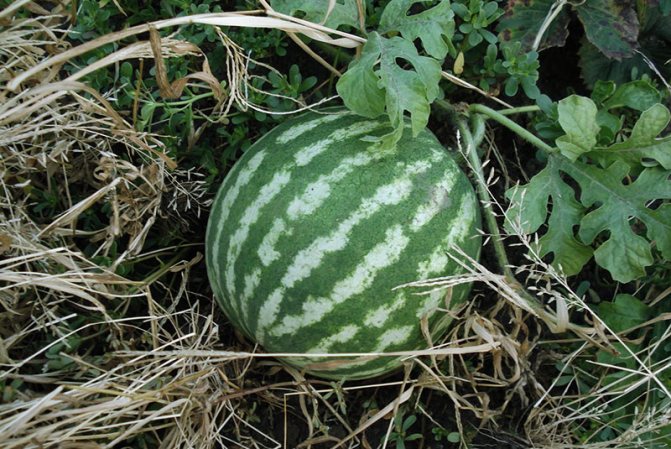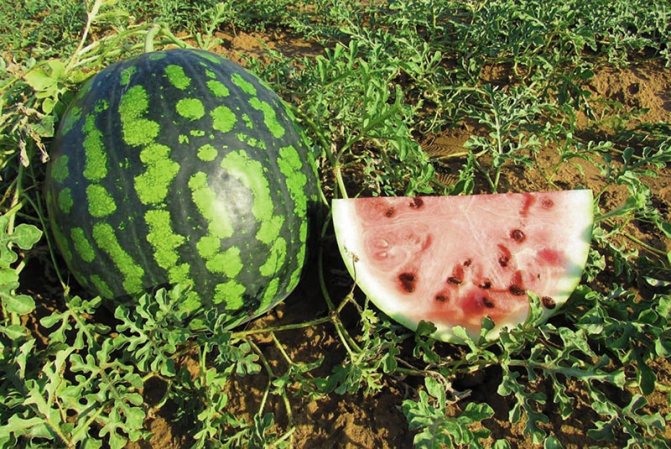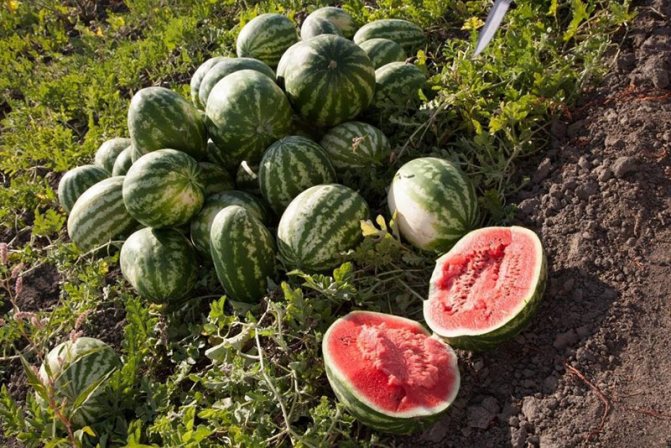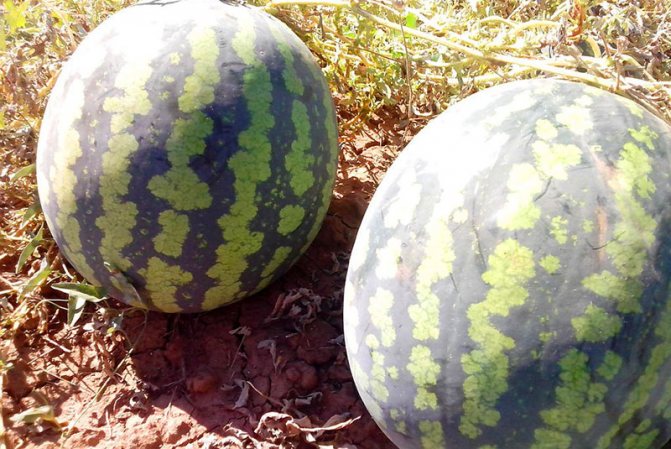Almost everyone loves to eat sunny berries in summer and autumn.
How to preserve watermelon until the New Year in order to enjoy its exquisite taste in winter? Many people only dream about this. In fact, there are 8 main ways to store food at home. Having examined each of them, we can choose the most optimal option. However, first we will find out which varieties are suitable for such a procedure. Then we will analyze the basic rules for storing fruits. And finally, we’ll look in detail at how to preserve watermelon until the New Year without losing its unsurpassed taste. On this topic:
Wild berries - name and photo of common...
May 21, 2020
What is contained in strawberries: vitamin composition and beneficial…
Feb 21, 2019
Timing for planting watermelons for seedlings and open ground
May 16, 2018
Gardener's Guide: Everything you need to know about growing...
Mar 14, 2018
BACK FORWARD 1 of 25
Choosing watermelon for long-term storage
The first step on the path to long-term storage of watermelons is their correct choice. It is necessary to select fruit that is already ripe, but not overripe, and, of course, not green.
![]()
A good ripe watermelon should have a hard, glossy bark, smooth, without the slightest damage in the form of cracks, deep scratches, dents, or abrasions. If any of the above is present, this leads to bacteria penetrating inside the watermelon and its contents spoil and begin to ferment.
If there are stripes on the bark, they should be bright and clear. You can determine ripeness by its characteristic sound: if, after patting the bark with your palm, a ringing sound is heard, then this means the ripeness of the fruit; if it is deaf, it is advisable to select another specimen. Another criterion is the yellow spot left on the bark in the place where it lay on the ground. It also indicates ripeness; white indicates unripeness.
For long-term storage, it is better to choose fruits of medium and above average size, that is, approximately 4-5 kg. These are easier to handle and fold for storage. It is more difficult to preserve small watermelons, as they dry out faster and become limp from the inside.
How to choose the right watermelon for storage
It is recommended to consider “Astrakhan Striped” and “Popovka” as “lying” varieties. “Astrakhansky Marble”, “Bykovsky 15” and “Melitopolsky 143” will be slightly less durable.
In addition to the variety, attention should be paid to the fruits themselves.
Terms of purchase
We do not buy watermelons for storage in early or mid-August.
The best time to purchase is the end of September. It is then that the fruits will be the sweetest and ripest, without the risk of increased nitrate content in them.
![]()
Appearance and integrity
If the selected variety should have stripes, look at their outlines: bright, with a noticeable border, indicate the good quality and naturalness of the product.
Otherwise (the stripes are blurred), the watermelon was most likely subjected to accelerated growth (the risk of buying a watermelon with nitrates).
Fruits lying directly on the ground are also not worth buying - microcracks in the peel will reduce the shelf life, and a watermelon with them can begin to rot in just a few weeks.
We choose fruits with a smooth rind without dents or damage.
Size and place of purchase
It is best to purchase medium-sized berries from the entire batch, since too large ones may be overripe.
- Be sure to pay attention to the condition of the halo under the tail - it should be keratinized, not fresh green. This indicates good ripeness of the watermelon.
- It is better not to buy melons in the supermarket - as a rule, they supply unripe fruits, and these will not have sufficient sweetness in the future.
- If watermelons have grown in your own garden bed, then we remove them for storage approximately 4-5 days before the planned harvest.
You can read about more detailed nuances of choosing a striped berry in our article “How to choose the right watermelon at the market and in the store.” But even if the variety is chosen correctly, storage cannot be guaranteed without other, equally important conditions.
Methods for long-term storage of watermelons at home
The options will differ depending on where this happens - in your own house or in a high-rise building, in an apartment. In a private estate, it is most convenient to store it in an ordinary cellar or in similar premises - in the basement and in the underground. In a city apartment, you can use a pantry, balcony or loggia to store watermelons for the winter.
At room temperature
It is clear that the room is always warm, and humidity levels may change. Neither heat nor humidity contribute to long-term storage, so you should not count on being able to store watermelon at home in a room until winter. At best, the fruits will last 4-5 weeks. It is best to choose thick-barked varieties of late-ripening varieties and slightly unripe specimens in which a lot of moisture has already accumulated for storage in such conditions.
On the balcony
![]()
Naturally, the balcony or loggia must be glazed and insulated so that when frost sets in, the watermelons do not freeze. Like any pumpkin fruit, if the bark is damaged, including from low temperatures, they begin to rot and quickly deteriorate. Until cold weather, watermelons can be stored uncovered on the balcony; before frost sets in, they need to be covered with some kind of insulating material. Once it warms up, open again.
In the cellar
This place is much better suited for storing watermelons, as well as other garden products. The underground storage is cool and humid, there are no temperature changes, which has a good effect on storage. Before placing products in it, the room must be cleaned, disinfected, ventilated and whitened with lime.
![]()
It is advisable to store the watermelon harvest in the cellar separately from other vegetables, as they spoil faster from such proximity and absorb other people’s odors. They should be placed in the cellar so that they do not touch each other if possible. Place on low pallets, on shelves, spread a layer of straw, peat, dry pine needles, moss and put berries on it in 1 layer. If there are few watermelons, then each of them can be lowered into a box with thick walls and completely covered with slightly damp sand. There are 2 more packaging options for storage:
- Coat the watermelon with a thin layer of clay, alabaster, or pour warm wax or paraffin. After the layer has dried, store them.
- Wrap each fruit in a thin cloth, clean paper, put it in a net and hang it from the ceiling.
In paraffin or clay, the fruit will remain fresh much longer than simply placed on racks.
We recommend reading
How to grow and care for watermelons in open ground
How to correctly call watermelon fruits - fruit, berry, vegetable or pumpkin
Technology for growing watermelons in a greenhouse: variety selection, care
Technology of planting watermelons with seeds for seedlings and in the ground
Storage conditions: up to 3-5 (up to 10 °C), moderate humidity (about 80%). The first time after planting, you need to inspect all the watermelons and immediately remove those that have begun to spoil, turn the rest over, and systematically ventilate the room. The remaining ones, subject to storage conditions, can last until February, that is, there is a possibility that they will definitely be preserved for the New Year's table.
In a refrigerator
![]()
The optimal place to store watermelon in the absence of a cellar is the refrigerator. The ambient temperature and humidity in it are constant. The only drawback is that due to the size of large fruits, only 1-2 pieces will fit in the refrigerator, so it is not suitable as an option for long-term storage of products. It is also not advisable to store watermelons in the refrigerator for a long time because they easily absorb the odors of other foods.
An already cut but uneaten watermelon should also be kept in the refrigerator. To keep it longer, you need to turn it cut side down, place it on a wide and shallow plate and wrap it together in cling film.
In the freezer
![]()
Not whole watermelons are stored frozen, but pre-cut into small pieces. First you need to wash the fruit under water, cut it into pieces, freeze them in the freezer, then put them in food containers, close them tightly with a lid and put them back in the freezer. Storing watermelons in this form can last a whole year, but we must remember that they cannot be defrosted or re-frozen: the pulp quickly loses its characteristic taste and structure. Frozen pieces can be used to make refreshing drinks. The downside of this method is that you won’t be able to freeze a lot of watermelons for the winter, because you need to leave room for other products.
Storage of workpieces
Watermelon preparations are stored, like other products, in a cool, dark and dry place. You can leave the cans of product in the room, but you need to find the darkest and coldest corner in it. In your home, the best place for preparations is the cellar. The shelf life of canned food is until next season.
![]()
Looking for suitable varieties
![]()
With the arrival of winter, the diet changes dramatically. Various pickles, canned vegetables, oranges, tangerines and bananas appear on the table. However, fresh aromatic watermelon will delight not only children, but also adults. To receive such a gift in the cold season, it is important to choose the right melon variety.
The following options are suitable for the case:
- “Striped” (the fruits are dark green and have clearly defined stripes);

- “Astrakhan” (spherical berries, dense pulp);

- “Gift of the Sun” (successfully grown in Siberia, the fruits are strong and small in size);

- “Volzhsky” (thick-skinned dark green melon);

- “Popovka” (distinguished by large-sized seeds);

- “Chill” (spherical berries with scarlet pulp).

Practice shows that mid-season crop varieties are unsuitable for long-term storage. Despite their apparent strength, they quickly deteriorate.
Japanese breeders have developed the only watermelon in the world that has a black rind.
How long can watermelon be stored?
Mid-ripening varieties in their entirety are stored in the refrigerator for 2.5-4 months, early-ripening varieties with thin bark - 1.5-2 months. Cut watermelon can be stored in the refrigerator for only 2-3 days. During this time, you must try to eat it; long-term storage for cut fruits is not provided.
In the cellar, barn, or underground, the fruits will last longer and it is in them that you can leave the selected fruits until the New Year. However, no matter how profitable storage is, we must remember that watermelon that has been stored for a long time has a significantly inferior taste to summer watermelon, and the content of nutrients decreases in proportion to the storage time.
Which watermelons last long?
![]()
Few people know, but melons and melons are shelf-stable products.
Under the right conditions, striped berries can last up to 3 months, while completely retaining their taste properties and being “just like from the garden.”
Thick-skinned, late-ripening varieties will be good - only these are suitable for planting if you are interested in understanding in practice how to store watermelons until the New Year and beyond.
They retain moisture well and retain elasticity. These varieties include Volga, Caucasian and Central Asian. Examples of excellent long-stored varieties are “Astrakhansky Polosatyy”, “Volzhsky” and “Popovka” , and recommended ones, subject to strict observance of all conditions, are “Astrakhansky Marble”, “Bykovsky”, “Melitopolsky”, “Dessertny”. Modern varieties without seeds lend themselves well to storage.
To please your family with a fresh dessert for the New Year, you must initially choose the right fruit for long-term storage:
- Before storing watermelons, wait until the end of the season; there is no need to buy the first fruits that appear ;
- if the berry is grown independently, then there is no need to fertilize it with growth accelerators;
- shopping from dubious people or at unorganized points along the road is dangerous. Direct rays of the sun contribute to the rapid ripening of the berry, microcracks in the peel when lying on the ground provoke the penetration of microbes into the pulp, and heavy metals from exhaust gases are absorbed into the peel within a few hours;
- fruit bought in a supermarket is also not suitable for storage, because they are usually delivered to stores unripe;
- In the question of how to preserve a watermelon longer, all the nuances are important, including the weight of the fruit. Optimal weight - 4-5 kg ;
- When choosing a watermelon, pay attention not only to the dryness of the tail, but also the halo around it. The tail can dry out in the store, but a dry halo indicates ripened fruit in the garden ;
- the correct “lying” spot of the fruit, if present, should be small and yellow in color. A whitish spot is a sign of the presence of nitrates in the pulp;
- The presence of pesticides will also be indicated by blurred stripes on striped varieties of watermelon. Clear and contrasting stripes will appear only on high-quality berries . The shiny gloss of the peel is another way to choose a product without harmful substances.
- The fruit selected for storage should not have external defects on the skin, cracks, scratches, or dents.
- Since watermelon does not ripen during storage , you should initially take ripe specimens when purchasing. A dull resonating sound when tapped, a smaller size with other identical parameters, and the “female” sex of the berry (a wide halo on the opposite side of the tail) are signs of a juicy and sugary fruit. Overripe fruit can only be stored in the refrigerator for no more than 3 days.
Where is the best place to store fresh watermelons in an apartment?
There are not many places in the apartment that would meet all the above requirements, but they do exist. The most suitable premises for long-term storage are the following:
- pantry;
- glazed loggia;
- bathroom or any other poorly lit room with low temperature;
- mezzanine.
In any of these places, “sunny fruits” will be stored for a long time. However, choosing the right storage is not the only key to success.
![]()
Methods for storing watermelons before winter
There are many proven methods for storing sweet fruits with success. All of them are effective and available even at home:
- In the newspaper.
Wrap the watermelon loosely in dry newspaper, place it in a net and hang it up.
- In alabaster or clay.
Dilute the alabaster with water and coat the berries. After the first layer has dried, apply the second. Once dry, also hang the watermelon in the net. Alabaster can be replaced with clay.
Latest articles about gardening
How to replant strawberries in the fall video
How to prepare hydrangea for winter?
- Storage in ashes.
- Ash serves as an analogue to aging fruits in sand. If for certain reasons you decide to resort to this method, choose ashes from burning branches of fruit trees.
- The “preservation” technology is identical: pick up a wooden box, line the bottom with ash, lay out the berries and sprinkle them. Duration of aging - until January.
- Net storage.
- If you plan to save a small harvest until the New Year, use a string bag or fine mesh. Select one device for each berry.
- Wash the fruits with newspaper, parchment paper or album sheets, and send them inside. Hang the net from the ceiling in the basement or cellar. It is important to prevent the fruits from touching each other.
- Storage in moss.
- To use this method, you need to collect moss in the fall. It must be dry and whole, otherwise the watermelons will rot. Before you start packing the berries, spread the moss out in the sun and leave it to dry for 2 days.
- Choose a wooden box of the appropriate size. It would be better if each copy was given a separate box. Line the bottom with moss, send the watermelon inside, wrap it on all sides, and tamp it down.
![]()
Storage conditions for fresh watermelons
The places where fresh watermelons will be stored before New Year must be:
- ventilated;
- dark;
- cool (air temperature in the storage should not be higher than +5-+8 °C);
- with a relative humidity of 60-80%, but no more. In a dry room, the berries will quickly lose their juiciness, and in a too humid room they will simply spoil.
![]()